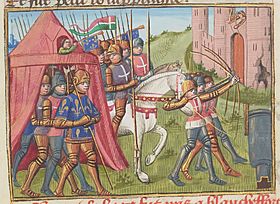Battle of Blanquefort facts for kids
Quick facts for kids Battle of Blanquefort |
|||||||
|---|---|---|---|---|---|---|---|
| Part of the Hundred Years' War | |||||||
 Battle of Blanquefort, miniature from the Vigiles du roi Charles VII by Martial d'Auvergne, c. 1484 |
|||||||
|
|||||||
| Belligerents | |||||||
| Commanders and leaders | |||||||
| Gadifer Shorthose Thomas Gassiot |
Arnaud-Amanieu d'Albret John, Count of Penthièvre Robin Pettilow |
||||||
| Strength | |||||||
| 7,000–10,000 men | 400–3,000 men | ||||||
| Casualties and losses | |||||||
| 1,500–2,500 killed | Unknown | ||||||
The Battle of Blanquefort was an important fight during the Hundred Years' War. It happened on November 1, 1450. In this battle, a French army managed to trick English and Gascon soldiers out of the city of Bordeaux.
Bordeaux was a key city in Gascony, a region controlled by England at the time. The battle ended with a big victory for the French. Many English and Gascon foot soldiers were killed. Locally, people called this battle La Male Journade, which means The Bad Day. This battle was the start of a new plan to push the English completely out of Gascony.
Contents
What Was the Hundred Years' War?
The Hundred Years' War was a very long series of conflicts. It lasted for more than 100 years, from 1337 to 1453. It was mainly fought between the Kingdom of England and the Kingdom of France.
The main reasons for the war were:
- Who should be the king of France.
- Who owned important lands in France, especially Aquitaine (also known as Gascony).
England had controlled parts of France for a long time. The French kings wanted to unite all of France under their rule. This long war shaped both countries.
Why Was Gascony So Important?
Gascony was a region in southwestern France. It was very important to England for several reasons:
- Trade: Gascony was famous for its wine. English merchants made a lot of money from this trade.
- Power: It was one of the last major areas in France still controlled by England. Losing it would mean a big loss of power and influence for the English king.
- History: England had held lands in France since the 12th century. Giving them up was not something they wanted to do easily.
By 1450, the Hundred Years' War was nearing its end. France had gained back much of its land. Gascony was one of the last strongholds for the English.
Who Fought at Blanquefort?
The battle involved two main sides:
- The English and Gascons: These were soldiers from England and local Gascon fighters who supported the English king. Their commanders included Gadifer Shorthose and Thomas Gassiot. They had a large force, estimated to be between 7,000 and 10,000 men.
- The French: These were soldiers loyal to the King of France. Their leaders were Arnaud-Amanieu d'Albret, John, Count of Penthièvre, and Robin Pettilow. The French army was much smaller, with about 400 to 3,000 men.
Even though the English and Gascons had more soldiers, the French had a clever plan.
What Happened During the Battle?
The Battle of Blanquefort took place near the town of Blanquefort, close to Bordeaux. The French army wanted to capture Bordeaux. However, attacking a strong city directly was risky.
So, the French commanders came up with a plan:
- They pretended to be a smaller, weaker force.
- They tried to make the English and Gascon soldiers leave the safety of Bordeaux.
The plan worked. The Anglo-Gascon forces marched out to meet the French. They likely thought they could easily defeat the smaller French army. But the French had set a trap. When the battle began, the French fought fiercely. The Anglo-Gascon infantry (foot soldiers) suffered huge losses. Between 1,500 and 2,500 of their soldiers were killed.
The battle was quick and decisive. It showed the growing strength of the French army.
What Was the Result of Blanquefort?
The Battle of Blanquefort was a clear victory for the French. It had several important outcomes:
- French Victory: The French army won the battle, weakening English control in Gascony.
- Heavy Losses: The English and Gascon forces lost many soldiers. This made it harder for them to defend their remaining lands.
- Start of a New Campaign: This battle marked the beginning of a major French effort. This effort aimed to drive the English completely out of Gascony. This campaign lasted from 1450 to 1453.
- La Male Journade: The local name, The Bad Day, shows how devastating this defeat was for the English and their Gascon allies.
This battle was a key step towards the end of the Hundred Years' War. It showed that England's time as a major landholder in France was coming to an end. Just a few years later, in 1453, the war officially ended. England lost almost all its French territories, except for the port city of Calais.

